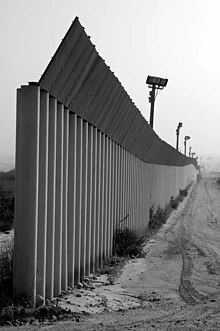 | ||
Tortilla wall
For the John Sladek short story, see The Great Wall of Mexico (short story).
Contents
The Tortilla Wall is a term given to a 14-mile (22.5 kilometer) section of United States border fence between the Otay Mesa Border Crossing in San Diego, California and the Pacific Ocean.
This "San Diego wall" was completed in the early 1990s. While there are other walls at various points along the border, the Tortilla Wall is the longest to date. No other wall sections have evolved distinct names, so The Tortilla Wall is often used to describe the entire set of walled defensive structures.
The Tortilla Wall is marked with graffiti, crosses, photos, pictures and remembrances of migrants who died trying to illegally enter the United States.
Effectiveness
The effectiveness of the wall has been significant according to U.S. Congressional testimony
...apprehensions along the region with a security fence dropped from 202,000 in 1992 to 9,000 in 1994.
The building of the tortilla wall is generally considered by Mexicans to be an unfriendly gesture. It is a symbol of the controversial immigration issue. It is argued that the wall simply forces illegal border crossings to be moved to the more dangerous area of the Arizona desert.
Expansion of the wall
In 2006, the U.S. Congress voted the Secure Fence Act of 2006 which authorized spending $1.2 billion to build 700 miles (1,100 km) of additional fencing on the southern border facing Mexico.
Anecdotal Wall Stories
Tunnels under the wall are still a common way to illegally cross the border. Some tunnels are quite sophisticated. One such tunnel created by smugglers ran from Tijuana to San Diego, was a half mile long, and included a concrete floor as well as electricity. Other tunnels have included steel rails, while some tunnels are simply dirt passageways or connect to sewer or drain systems.
As a stunt, a circus cannon was placed on the south side of the wall and an acrobat was blasted over the wall into the Border Field State Park in the U.S. He had his passport with him.
